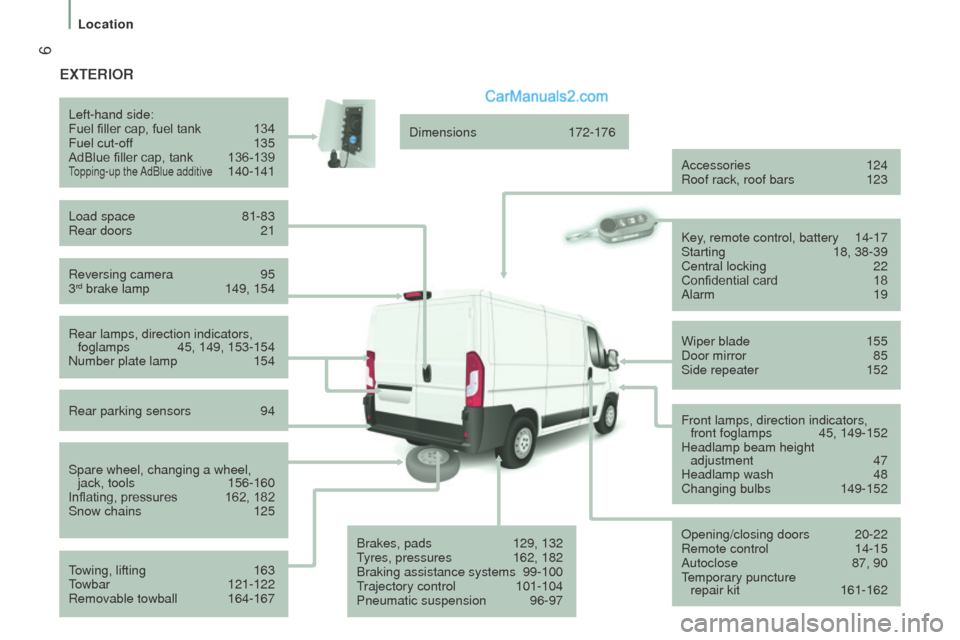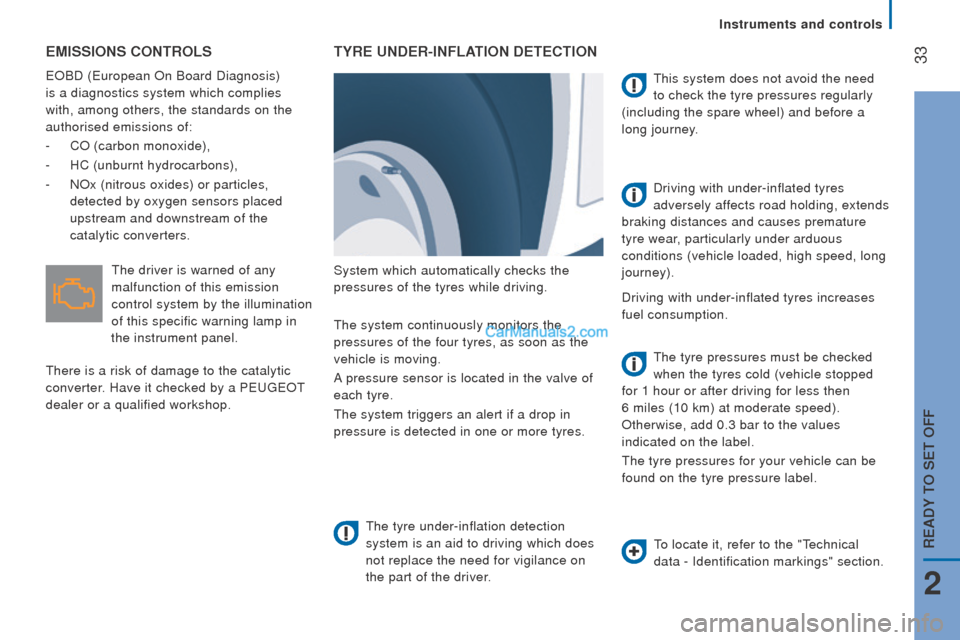Page 8 of 276

6
ExtErIor
Reversing camera 95
3rd brake lamp 149, 154
Left-hand side:
Fuel filler cap, fuel tank
134
Fuel cut-off 135
AdBlue filler cap, tank 136-139topping-up the AdBlue additive 140-141
Load space
81-83
Rear doors 21
Rear lamps, direction indicators, foglamps
45, 149, 153-154
Number plate lamp 154
Rear parking sensors
94
Spare wheel, changing a wheel, jack, tools
156-160
Inflating, pressures 162, 182
Snow chains 125
towing, lifting 163towbar 121-122
Removable towball 164-167 Dimensions
172-176
Accessories
124
Roof rack, roof bars 123
Brakes, pads
129, 132tyres, pressures 162, 182
Braking assistance systems 99-100trajectory control 101-104
Pneumatic suspension 96-97 Key, remote control, battery
14-17
Starting 18, 38-39
Central locking 22
Confidential card 18
Alarm 19
Wiper blade
155
Door mirror 85
Side repeater 152
Opening/closing doors
20-22
Remote control 14-15
Autoclose 87, 90temporary puncture repair kit 161-162
Front lamps, direction indicators,
front foglamps
45, 149-152
Headlamp beam height adjustment
47
Headlamp wash 48
Changing bulbs 149-152
ExtErIor
Location
Page 15 of 276

13
Limit the causes of excess consumption
Spread loads throughout the vehicle; place the heaviest items in
the bottom of the boot, as close as possible to the rear seats.
Limit the loads carried in the vehicle and reduce wind resistance
(roof bars, roof rack, trailer...).
At the end of winter, remove snow tyres and refit your summer
tyres.
observe the recommendations on maintenance
Check the tyre pressures regularly, when cold, referring to the
label in the door aperture, driver's side.
Carry out this check in particular:
-
before a long journey,
- at each change of season,
- after a long period out of use.
Don't forget the spare wheel and the tyres on any trailer or
caravan.
Have your vehicle serviced regularly (engine oil, oil filter
, air
filter, cabin filter...) and observe the schedule of operations in the
manufacturer's service schedule.
With a BlueHDi Diesel engine, if the SCR has a fault your vehicle
becomes polluting; go to a P
eugeOt dealer or a qualified
workshop as soon as possible to bring the levels of nitrous oxide
emissions back into line with the regulations.
When refuelling, do not continue after the 3
rd cut-off of the nozzle
to avoid any overflow.
At the wheel of your new vehicle, it is only after the first
1
800 miles (3 000 kilometres) that you will see the fuel
consumption settle down to a consistent average.
1
OVeRVIeW
Motoring & the environment
Page 34 of 276

32
FuEL GAuGE
the fuel level is tested every time the
ignition is turned on.
the gauge is positioned on:
-
F (Full): the fuel tank is full.
-
E (Empty): the reserve is now being
used, the low fuel warning lamp comes
on continuously.
the reserve when the warning first comes
on is approximately:
-
10 litres for 60 and 90 litre tanks,
-
12 litres for 120 litre tanks.
Fuel tanks of different capacities (60 and
120 litres) are available as an option.
cooLAnt tEMPErAturE
the needle is positioned between
c (cold) and H (Hot):
normal operation.
In arduous conditions of use or hot climatic
conditions, the needle may move close to
the red graduations. If the needle enters the red zone or if the
warning lamp comes on:
-
stop immediately, switch of
f the ignition.
the fan may continue to operate for
a certain time up to approximately
10
minutes.
-
wait for the engine to cool down in
order to check the level and top it up if
necessary. Follow this advice:
the cooling system is pressurised. In order
to avoid any risk of scalding, unscrew the
cap by two turns to allow the pressure to
drop.
When the pressure has dropped, check the
level and remove the cap to top-up.
If the needle remains in the red zone,
contact a PeugeOt dealer or a qualified
workshop.
Refer to the "Checks - Fuel" section. Refer to the "Checks - Levels and
checks" section.
Instruments and controls
Page 35 of 276

33EMISSIonS controLS
eOBD (european On Board Diagnosis)
is a diagnostics system which complies
with, among others, the standards on the
authorised emissions of:
-
CO (carbon monoxide),
-
HC (unburnt hydrocarbons),
-
NOx (nitrous oxides) or particles,
detected by oxygen sensors placed
upstream and downstream of the
catalytic converters.
tYrE undEr-InFLAtIon dEtEctIon
System which automatically checks the
pressures of the tyres while driving.
the tyre under-inflation detection
system is an aid to driving which does
not replace the need for vigilance on
the part of the driver.
this system does not avoid the need
to check the tyre pressures regularly
(including the spare wheel) and before a
long journey.
Driving with under-inflated tyres increases
fuel consumption.
the system continuously monitors the
pressures of the four tyres, as soon as the
vehicle is moving.
A pressure sensor is located in the valve of
each tyre.
the system triggers an alert if a drop in
pressure is detected in one or more tyres.
the tyre pressures must be checked
when the tyres cold (vehicle stopped
for 1 hour or after driving for less then
6 miles (10 km) at moderate speed).
Otherwise, add 0.3 bar to the values
indicated on the label.
the tyre pressures for your vehicle can be
found on the tyre pressure label.the driver is warned of any
malfunction of this emission
control system by the illumination
of this specific warning lamp in
the instrument panel.
there is a risk of damage to the catalytic
converter. Have it checked by a P
eugeOt
dealer or a qualified workshop.
to locate it, refer to the "technical
data
- Identification markings" section.
Driving with under-inflated tyres
adversely affects road holding, extends
braking distances and causes premature
tyre wear, particularly under arduous
conditions (vehicle loaded, high speed, long
journey).
2
rEAdY to SEt oFF
Instruments and controls